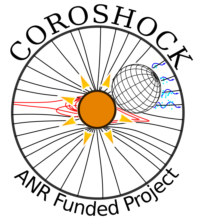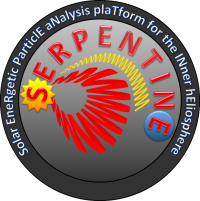Research Projects
Awarded Research Projects
PyThea
![]()
PyThea is a newly developed open-source Python software package that provides tools to reconstruct coronal mass ejections (CMEs) and shocks waves in three dimensions, using multi-spacecraft remote-sensing observations. This project has recieved a NASA Grant in Research Opportunities in Space and Earth Science (ROSES)–2022 in the Heliophysics Tools And Methods Program (NNH22ZDA001N-HTM) program element.
Role: Principal Investigator, Duration: 1 year (2023 - 2024)
Research Projects (Active Involvement)
COROSHOCK

COROSHOCK was an ANR funded project that aimed to address one of the remaining unsolved questions in solar physics: How and where are solar energetic particles accelerated to high energies?
We aimed to answer the scientific hypothesis that coronal shocks act as the particle accelerators of the high-energy particles that produce the high-energy solar energetic particle events observed in-situ and γ-ray events remote sensed. We exploited remote-sensing and in-situ data in an integrated manner to test the shock hypothesis as the prime particle accelerator. We combined advanced coronal shock models with models that account for the physical processes known to operate in the corona and in the interplanetary medium during the acceleration and transport of particles and adapt existing advanced numerical models.
At the end of the COROSHOCK project we have elucidated the role of coronal shocks as strong accelerators of the energetic particles that form the SEPs measured in-situ near 1AU and the high-energy electromagnetic radiation prodused near the Sun and observed remotely.
Role: Post Doctoral Researcher, Duration: 5 years (2018 - 2022)
FORSPEF
The FORecasting Solar Energetic Particles and Flares (FORSPEF) is a tool that provides forecasting of solar eruptive events, such as solar flares (SF) with a projection to coronal mass ejections (CMEs) (occurrence and velocity) and the likelihood of occurrence of a solar energetic proton (SEP) event. It also provides nowcasting of SEP events based on actual SF and CME near real-time alerts, as well as nowcasting of SEP characteristics (peak flux, fluence, rise time, duration) per parent solar event. The FORSPEF Tool provides notifications to registered users on the Occurrence and the Expected Characteristics of forthcoming Solar Energetic Particle (SEP) radiation storms, either for a given SF or for a CME, with known characteristics. All notifications are issued when the calculated probability of SEP Occurrence is >=0.25. Predictions are issued for all > C1.0 soft X-ray flares. The prediction time in the forecasting scheme extends to 24 hours with a refresh rate of 3 hours while the nowcasting mode provides a complete prognosis of SEP events from their probability of occurrence to their expected characteristics (in terms of SEP event’s peak flux, peak time), based on near-real time SF data, with a refreshing rate of ~15-20 minutes and on near real-time CME data with a refreshing rate of ~6 hours.
Role: Research Assistant, Duration: 1 year (2015 - 2016)
Hellenic National Space Weather Research Network
Role: Research Assistant, Duration: 3 years (2013 - 2015)
SEPServer
The project aimed at producing a sustainable tool for a broad research community –to investigate solar energetic particles (SEPs) and their origin– through the creation of a server of SEP data, related electromagnetic (EM) observations, and analysis tools. It also aimed to add new knowledge on the production and transport of high energy particles during solar eruptions, by performing detailed analyses of an extensive set of measurements of SEP in the interplanetary (IP) medium, along with concurrent observations of EM emissions from radio to gamma-ray frequencies.
The SEPServer project has produced a versatile web-based tool for the analysis of SEP events, the SEPServer (www.sepserver.eu). The server contains a comprehensive set of observations of SEPs in the interplanetary medium and of the related solar EM emissions stored in a relational database. In addition, the server provides access to state-of-the-art modelling tools to infer the characteristics of particle emission from the Sun. SEPServer has contributed to new knowledge on the outstanding problem of solar particle acceleration by providing a preliminary analysis of the onset time of hundreds of SEP events and their SEP release times. In addition, for a limited set of well-observed events, it has provided the release-time profiles inferred using simulation-based analyses. The comparison of the release timings with the related solar EM emissions has been investigated and made available.
Role: Graduate Researcher, Duration: 3 years (2011 - 2013)
Collaborative Research Projects
SERPENTINE

The Solar EneRgetic ParticlE aNalysis plaTform for the INner hEliosphere (SERPENTINE) is a H2020 project that aims to answer several questions about the origin of solar energetic particle events and to provide a platform for the analysis and visualization of high-level datasets.
SERPENTINE will focus on unravelling the causes of currently poorly understood large gradual and widespread SEP events. These events also pose the greatest radiation risk to spacecraft outside the shielding provided by Earth’s magnetic field, having thus major importance for space weather prediction. The project uses key data from the most recent European and US missions, i.e., Solar Orbiter, Parker Solar Probe and BepiColombo, which have opened completely new avenues to investigate energetic particles.
SERPENTINE platform is expected to significantly foster the further exploitation of the data from European space-borne and ground-based instrumentation and interactions between different communities during and after the project period.
ShockSEE
ShockSEE is a project funded by the Research Academy of Findland that aims to investigate the role of shocks for solar energetic electron events with the new-generation heliospheric fleet. Widespread electron events constitute the first strong indication of the presence of electron acceleration by a wide and CME-driven shock. However, as spacecraft observations are determined by a mixture of different possible processes such as a contribution by a flare, effects of interplanetary transport, and shock acceleration, these contributions have to be quantified. SHOCKSEE aims to a comprehensive analysis of spacecraft observations, complemented by various state-of-the-art models to investigate different physical effects and address several top-level science questions.
EUHFORIA 2.0

The EUHFORIA 2.0 project aims at developing an advanced space weather forecasting tool. The project addresses the geoeffectiveness of the impacts of CMEs, CIRs, and SEPs and mitigation of (part of) the damage these cause.
The project also considers extreme events, but the emphasis is on improving the prediction of “normal” space weather and its effects, in particular on its applications to forecast geomagnetically induced currents (GICs) and radiation on geospace. The project thus addresses many challenging aspects of space weather that are interlinked in a complicated way from Sun to Earth and provides therefore also the potential for some scientific breakthroughs.
